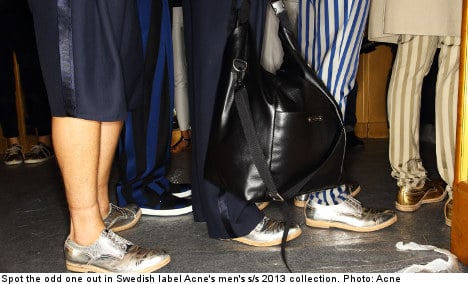Smart shorts not boardies, mind. A little above the knee and not below. In an “equal society”, if women can wear skirts, men can wear shorts. Simple. The only difference here is the matter of hair. And there’s nothing wrong with fuzzy pins.
An additional after-thought is the matter of feet. For, and I stress, it is not ok to wear flip-flops or the like to work – unless you’re employed by a university student union – a loafer or a smart lace-up brogue or the like are the only suitable options boys. Short, coloured socks permitted.
To perfect your look, head to H&M’s cooler, older cousin COS. This trendy outfit does work-perfect pieces in amazing, high-end shapes and has smart men’s shorts in abundance. So there’s just no excuse to get it wrong fellas.
I suppose if you live in cool Södermalm, your attitude to dressing for work is probably a lot like your surroundings i.e. hip, laid-back and probably idiosyncratic. If you’re a man in this part of town, tailored shorts are probably not your bag. A suit? Heaven forbid. In fact, walking around Sofo just before nine, one wouldn’t think the working day was about to begin. As for Söder’s women, it’s sack-like dresses or carrot-top trousers and clunky heels. No clichéd 80s stiletto and pencil skirt combos here.
IN PICTURES: See Also: Six ways to dress like a Swede – revealed
But then who can blame this style-savvy lot? In the heat, relaxed work-wear is definitely the way to go.
The days of obligatory three-piece suits are, for the most part, long gone anyway and women no longer need to bind themselves in a blouse and calf-length skirt with a string of pearls and high heels to go to work.
That said, I’m all for the traditional work garb. Dapper guys in pastel tailoring; women in non-fussy dresses and crisp white shirts in the style of Carolina Herrera. If Stockholm’s hipster locale isn’t up for tailoring, I know a place in Stockholm that certainly is.
For fear not formal fans, Östermalm still has it. Around Stureplan where a triangle of handkerchief poking just so out of the top pocket is de rigueur, formality reigns. Pretentious? Of course. Fanciful? Yes please. Just how Östermalm’s gentlemen manage to stay cool in the sun in their expensive suits is another matter. Air con and fans made of cash probably help.
And traditional doesn’t mean boring. On the train home last week I came across one particularly dapper fellow with a major affinity for brown tweed. His check suit with accompanying dicky bow made him look half university professor circa Indiana Jones in Raiders of the Lost Ark and half thrift-shop owner. A little hipster, a dash traditionalist, the dude’s boldness and imagination was admirable.
If it’s an argument of formal versus casual why not hit the mid-mark (especially in the heat): a tee and tailored trousers for the guys (or shorts); for the ladies, a sleeveless shirt dress or a simple elegant shift that will never tire.
If, like me, merging work wear and warm weather is still just too much to bear, we needn’t worry for too much longer.
It’ll soon be winter.
Hussey’s How To… Find style inspiration in unexpected places. Those hard-working purveyors of the law, the Swedish Police Force, are worth a peek. The båtmössa or boat cap is chic, no? Scour second-hand shops for likewise pointy hats and pop one atop your head.
I promise you’ll be smiling all the way to work safe in the knowledge that not only do you look earth-shatteringly chic and a little avant-garde, but you’re also showing support for the country’s law-enforcers. Job done.
Victoria Hussey




 Please whitelist us to continue reading.
Please whitelist us to continue reading.
Member comments